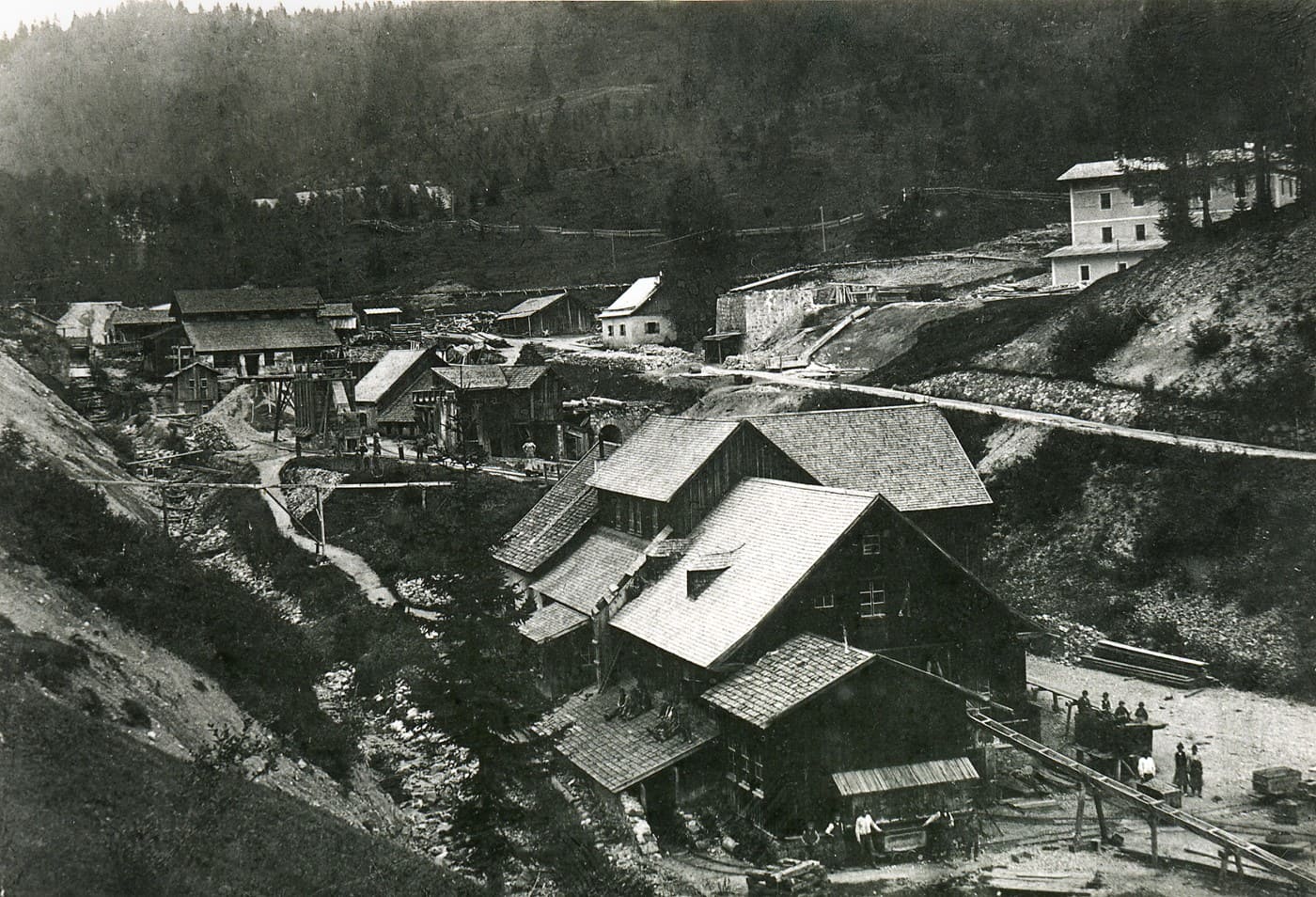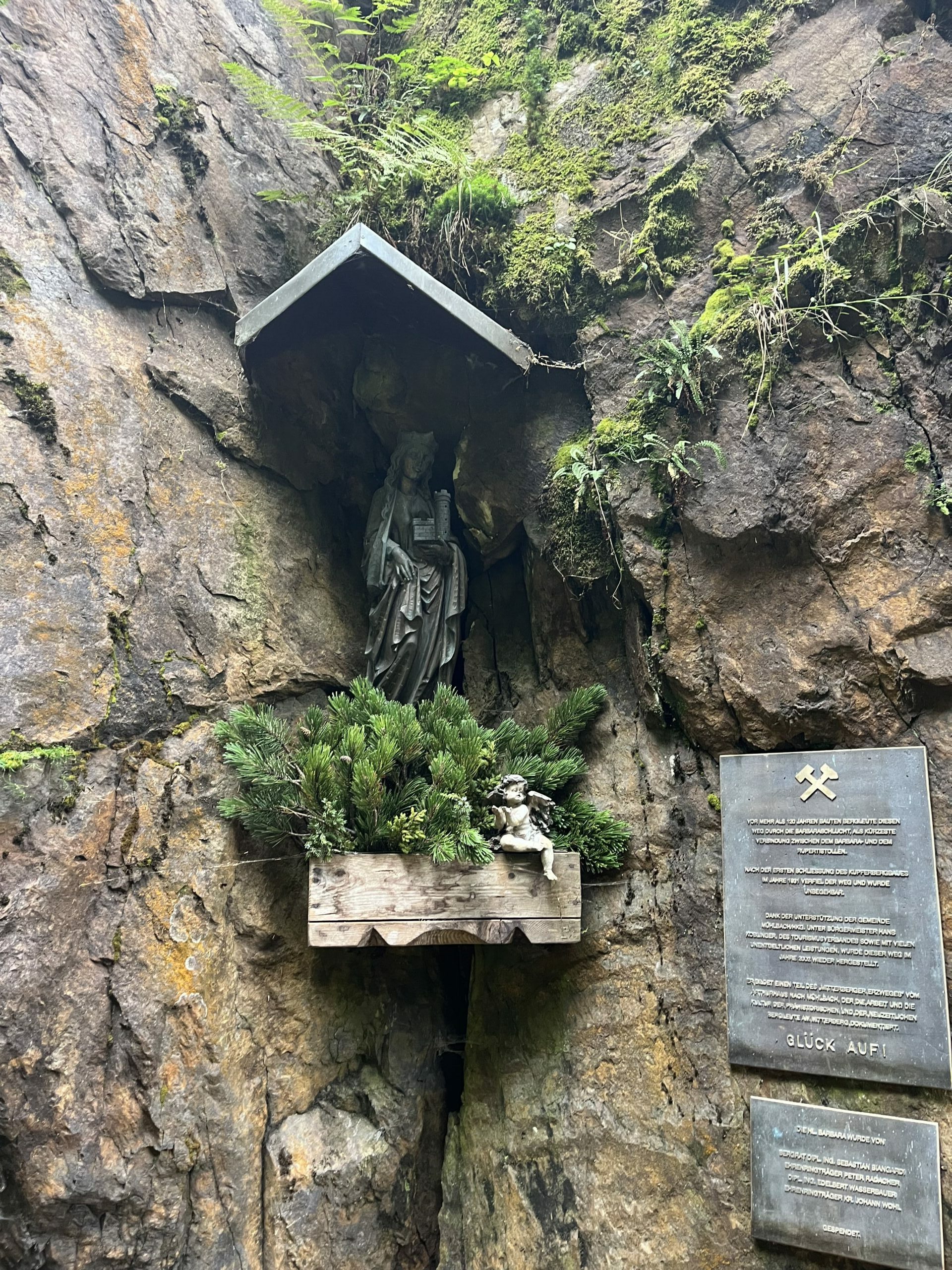Johann-Barbara Adit
In front of us, slightly to the left, right
next to the old blacksmith building, is the
entrance (portal) of the "Johann-Barbara
Adit.“ Initiated in 1868, it stretches over
a length of 6510 meters and connects
with the "Daniel Adit“ (initiated in 1891,
breakthrough in 1896), extending to the
east side of the Hochkeil.
At this location, the ore was processed
for further transportation. Thus, the
"Washing and Stamping Plant 2“
(1849) was established here, along
with workshops, feeding stations, and
accommodation.
The miners mainly subsisted on the regional dish called "Mus“ (Muas), consisting of milk, water,
flour, wheat semolina, and salt.
In winter, milk consumption was often
entirely avoided.
The number of severe
deficiency diseases, especially scurvy,
noticeably increased. In the 1870s, the
mining administration took charge
of supplying its miners. Stables were
constructed for the accommodation of
grazing cattle. To increase the annual hay
yield, fallow land was cleared of stones
and transformed into productive meadows
using cow dung. Only then was it possible
to ensure the wintering of livestock in the
high mountains, enabling year-round dairy
farming.
Kids
St Barbara
Do you know why many mines have a statue of St Barbara?
St Barbara is the patron saint of miners, which means that to this day she watches over the hard-working miners in the tunnels to ensure that nothing happens to them during their work. During the dangerous work underground, it can happen that accidents occur or even a tunnel collapses. This is where she protects her miners and women.
St Barbara's Day is celebrated every year on 4 December and in our region, branches of St Barbara are placed in a vase. These are branches of an apple or cherry tree that are placed in water on St Barbara's Day and are supposed to bloom until Christmas. These beautiful blossoms bring good luck for the New Year. A Barbara celebration is still held today in many mines and tunnels in honour of Saint Barbara.
St Barbara
St Barbara is the patron saint of miners who work in mines and tunnels. St Barbara is often depicted with a tower. According to legend, she was locked in a tower by her father, a rich merchant, to protect her. She was baptised there and became a Christian. Her father was against her faith and for this reason he had St Barbara murdered. St Barbara's Day is celebrated every year on 4 December, when branches of St Barbara's tree are put up and St Barbara's Day celebrations are held. If the branches of the apple or cherry tree blossom by Christmas, this brings good luck and blessings for the New Year. To this day, St Barbara's Day celebrations are still held in many mines and tunnels, as well as in the show tunnels in Hüttau, Mühlbach am Hochkönig and St. Veit im Pongau.
St Barbara
St Barbara is the patron saint of miners. She is said to have lived in the region of modern-day Turkey or Lebanon in the third century AD. She is said to have been the daughter of a rich merchant who locked her in a tower because of her beauty and to protect her. To this day, St Barbara is often depicted with a tower. She was secretly baptised in this tower and became a Christian. When her father realised this, he was furious and demanded that she turn her back on Christianity. However, St Barbara did not do so and so he had her beheaded.
St Barbara's Day is celebrated every year on 4 December, when a celebration is held in mines or tunnels in honour of St Barbara. In Hüttau, Mühlbach am Hochkönig and St. Veit, a St Barbara's Day celebration is also held in the show tunnels. In our region, it is traditional to put up branches of cherry or apple trees on this day. These are supposed to bloom until Christmas, bringing luck and blessings for the New Year. This custom goes back to the story that St Barbara watered a dried cherry branch in her tower. According to legend, this branch began to blossom after St Barbara was killed.




